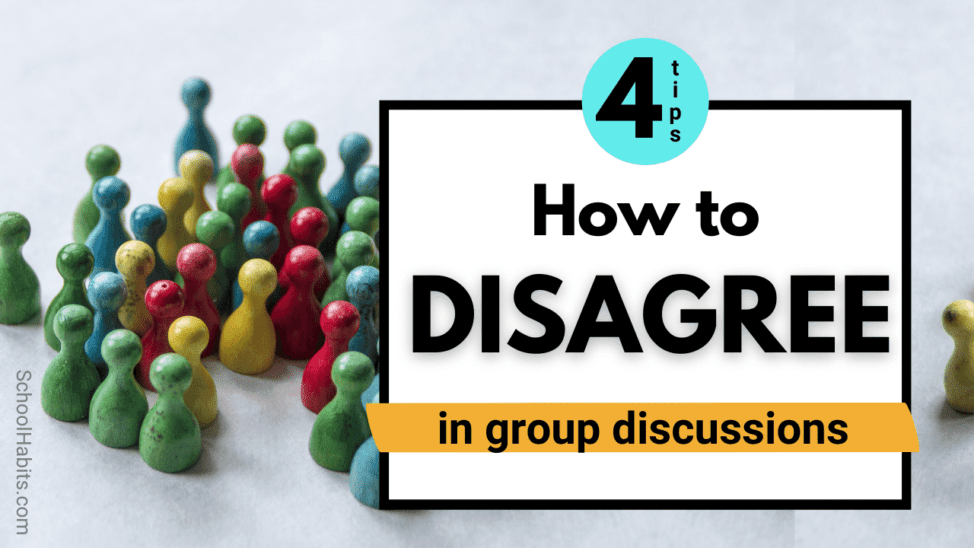By Katie Azevedo, M.Ed.
Whether you’re a student or a working professional, group projects, group discussions and meetings can be an effective way to collaborate and make decisions.
But working with others can also be challenging.
Group work can be challenging because it’s difficult to manage conversations when you or your group members disagree with each other.
If you haven’t read my post or watched my video about studying in groups, start there. Also, here are 17 more tips for working well with others – for when you’re done reading this tutorial here.
The following strategies will teach you how to disagree with someone in group discussions – in a way that’s polite, respectful, clear and assertive.
How to disagree with someone in group discussions, meetings and group projects
Remember, the goal of disagreeing with someone in a group discussion is not to prove yourself right or prove the other person wrong. The goal is to understand each other’s views and find a middle ground.
1. Know what you’re disagreeing with.
Before disagreeing with another person in your group, be certain that you clearly understand their argument. Have you misunderstood or misheard anything? The more clearly you understand their perspective, the more you’ll be able to frame your counterargument. You can do this by simply asking “Could you please re-word that?” or “Let me make sure I understand you correctly. What you’re saying is … [summarize your understanding of their argument].”
2. Validate the other person’s perspective – or part of it.
Before you disagree with someone in a group discussion, acknowledge at least some part of their perspective that you agree with. Doing so increases the chances of that person being receptive to what you have to say. Try something like “I really agree with what you said about [xyz], but I disagree with [abc].”
3. Time your response.
While you may get the urge to speak up the moment someone says something you disagree with, that’s not always smart. Sometimes the best time to disagree with someone is a few minutes later, or even after the meeting. (See tip #4). Timing your response correctly takes practice and you might not always get it right – but try taking your cues from others around you. Is the conversation friendly and is there lots of back-and-forth dialogue? It’s probably okay to speak up. Is the group discussion already heated, and are people already getting frustrated? Maybe save your words for when the conversation cools down.
If you choose to hold your response until a more opportune moment in the discussion, it can be helpful to remind your group members of the original argument you’re disagreeing with. Use a simple reminder like “Going back to what Joe said earlier about [xyz], I would like to add that …”
4. Know your audience and purpose.
It’s not always our place to disagree with someone in group discussions – and knowing this reality is very important. While self-advocacy is a valuable skill and disagreements often lead to constructive solutions, the greater skill is knowing when it’s appropriate to speak up.
First, know your audience. If your professor, boss or other superior has given the group instructions, it’s generally not appropriate to disagree (unless there’s an ethical issue, but I’m assuming my intelligent readers understand the difference between ethical and sketchy). Sometimes, we just have to do as we’re told because that’s our job – even if we want to disagree. Disobeying our superiors is called insubordination, and it’s something to be very careful with.
If the person you disagree with is your boss (or other superior), and your purpose for disagreeing with them is important to you, then meet with them privately after the meeting.
Second, know your purpose. It may also not be worth speaking up against a group member’s opinion if that opinion is irrelevant to the larger goal. For example, if you’re working on a school group project about the Paleolithic period and a group member brings up controversial opinions about politics, it’s not likely in the group’s best interest to engage in a political debate.
Know your audience, know your role, and (usually) only disagree when the outcome of that disagreement aligns with the purpose of the group discussion.
5 sentence templates for disagreeing in group discussions
If you struggle with framing your disagreements, you could use any of the 5 following sentence templates and customize them to your particular situation. And again, here are 17 more tips for working well with others.
- I really agree with what you said about [abc], but I disagree with [xyz].
- Thank you for your thoughts on [abc], but I’m actually thinking [xyz].
- I see your point about [abc]; however, I think [xyz] would work better because …
- I agree with your point about [abc], but I have a different view about [xyz].
- I understand what you’re saying about [abc], but the way I see it is [xyz].
Looking for more? Here are my 31 best class presentation tips for students.

